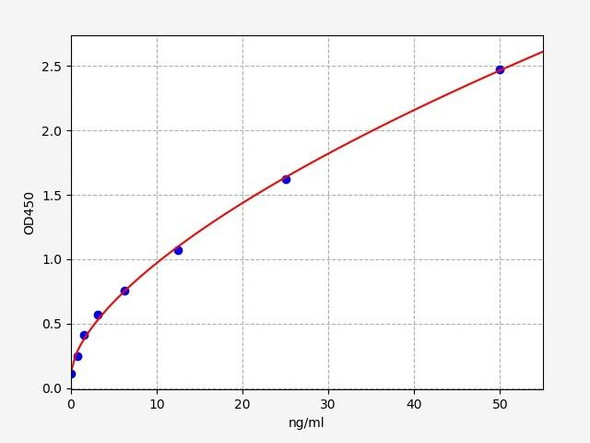Description
Human Alpha-crystallin B chain (CRYAB) ELISA Kit
The Human Alpha Crystallin B Chain (CRYAB) ELISA Kit is specifically designed for the accurate measurement of CRYAB levels in human samples such as serum, plasma, and cell culture supernatants. With high sensitivity and specificity, this kit provides reliable and reproducible results, making it an excellent tool for a wide range of research applications.CRYAB is a key protein involved in maintaining cellular health and protecting cells from stress and damage. Its dysregulation has been implicated in various diseases including neurodegenerative disorders, cardiovascular diseases, and inflammatory conditions.
By measuring CRYAB levels, researchers can gain insight into the pathophysiology of these diseases and potentially develop targeted therapies.Overall, the Human CRYAB ELISA Kit is a valuable resource for researchers studying the role of CRYAB in human health and disease, offering a convenient and effective method for quantifying CRYAB levels in biological samples.
| Product Name: | Human Alpha-crystallin B chain (CRYAB) ELISA Kit |
| SKU: | HUEB0472 |
| Size: | 96T |
| Target: | Human Alpha-crystallin B chain (CRYAB) |
| Synonyms: | Alpha(B)-crystallin, Heat shock protein beta-5, Renal carcinoma antigen NY-REN-27, Rosenthal fiber component, HspB5, CRYA2, HSPB5 |
| Assay Type: | Sandwich |
| Detection Method: | ELISA |
| Reactivity: | Human |
| Detection Range: | 0.156-10ng/mL |
| Sensitivity: | 0.089ng/mL |
| Intra CV: | 4.9% | ||||||||||||||||||||
| Inter CV: | 7.8% | ||||||||||||||||||||
| Linearity: |
| ||||||||||||||||||||
| Recovery: |
| ||||||||||||||||||||
| Function: | May contribute to the transparency and refractive index of the lens. Has chaperone-like activity, preventing aggregation of various proteins under a wide range of stress conditions. |
| Uniprot: | P02511 |
| Sample Type: | Serum, plasma, tissue homogenates, cell culture supernates and other biological fluids |
| Specificity: | Natural and recombinant human Alpha-crystallin B chain |
| Sub Unit: | Heteropolymer composed of three CRYAA and one CRYAB subunits (PubMed:20836128). Aggregates with homologous proteins, including the small heat shock protein HSPB1, to form large heteromeric complexes (PubMed:10751411). Inter-subunit bridging via zinc ions enhances stability, which is crucial as there is no protein turn over in the lens (PubMed:22890888). Interacts with HSPBAP1 and TTN/titin (PubMed:14676215). Interacts with TMEM109 (PubMed:23542032). |
| Research Area: | Cancer |
| Subcellular Location: | Cytoplasm Nucleus Translocates to the nucleus during heat shock and resides in sub-nuclear structures known as SC35 speckles or nuclear splicing speckles. |
| Storage: | Please see kit components below for exact storage details |
| Note: | For research use only |
| UniProt Protein Function: | CRYAB: a major structural protein of the eye lens. A member of the small heat shock protein (sHSP also known as the HSP20) family. Alpha-B is expressed in the lens as well as other tissues. Elevated expression of alpha-B crystallin occurs in many neurological diseases; a missense mutation cosegregated in a family with a desmin-related myopathy. |
| UniProt Protein Details: | Protein type:Heat shock protein; Chaperone Chromosomal Location of Human Ortholog: 11q22.3-q23.1 Cellular Component: actin filament bundle; cell surface; cytoplasm; cytosol; Golgi apparatus; microtubule cytoskeleton; mitochondrion; myelin sheath; nucleoplasm; nucleus; plasma membrane; Z disc Molecular Function:identical protein binding; metal ion binding; microtubule binding; protein binding; protein homodimerization activity; structural constituent of eye lens; unfolded protein binding Biological Process: aging; lens development in camera-type eye; microtubule polymerization or depolymerization; muscle contraction; muscle development; negative regulation of apoptosis; negative regulation of caspase activity; negative regulation of cell growth; negative regulation of intracellular transport; protein folding; protein homooligomerization; response to estradiol stimulus; response to hydrogen peroxide; response to hypoxia; stress-activated MAPK cascade; tubulin folding Disease: Cardiomyopathy, Dilated, 1ii; Cataract 16, Multiple Types; Myopathy, Myofibrillar, 2; Myopathy, Myofibrillar, Fatal Infantile Hypertonic, Alpha-b Crystallin-related |
| NCBI Summary: | Mammalian lens crystallins are divided into alpha, beta, and gamma families. Alpha crystallins are composed of two gene products: alpha-A and alpha-B, for acidic and basic, respectively. Alpha crystallins can be induced by heat shock and are members of the small heat shock protein (HSP20) family. They act as molecular chaperones although they do not renature proteins and release them in the fashion of a true chaperone; instead they hold them in large soluble aggregates. Post-translational modifications decrease the ability to chaperone. These heterogeneous aggregates consist of 30-40 subunits; the alpha-A and alpha-B subunits have a 3:1 ratio, respectively. Two additional functions of alpha crystallins are an autokinase activity and participation in the intracellular architecture. The encoded protein has been identified as a moonlighting protein based on its ability to perform mechanistically distinct functions. Alpha-A and alpha-B gene products are differentially expressed; alpha-A is preferentially restricted to the lens and alpha-B is expressed widely in many tissues and organs. Elevated expression of alpha-B crystallin occurs in many neurological diseases; a missense mutation cosegregated in a family with a desmin-related myopathy. Alternative splicing results in multiple transcript variants. [provided by RefSeq, Jan 2014] |
| UniProt Code: | P02511 |
| NCBI GenInfo Identifier: | 117385 |
| NCBI Gene ID: | 1410 |
| NCBI Accession: | P02511.2 |
| UniProt Secondary Accession: | P02511,O43416, Q9UC37, Q9UC38, Q9UC39, Q9UC40, Q9UC41 B0YIX0, |
| UniProt Related Accession: | P02511 |
| Molecular Weight: | 20,159 Da |
| NCBI Full Name: | Alpha-crystallin B chain |
| NCBI Synonym Full Names: | crystallin alpha B |
| NCBI Official Symbol: | CRYAB |
| NCBI Official Synonym Symbols: | MFM2; CRYA2; CTPP2; HSPB5; CMD1II; CTRCT16; HEL-S-101 |
| NCBI Protein Information: | alpha-crystallin B chain |
| UniProt Protein Name: | Alpha-crystallin B chain |
| UniProt Synonym Protein Names: | Alpha(B)-crystallin; Heat shock protein beta-5; HspB5; Renal carcinoma antigen NY-REN-27; Rosenthal fiber component |
| Protein Family: | Alpha-crystallin |
| UniProt Gene Name: | CRYAB |
| UniProt Entry Name: | CRYAB_HUMAN |
| Component | Quantity (96 Assays) | Storage |
| ELISA Microplate (Dismountable) | 8×12 strips | -20°C |
| Lyophilized Standard | 2 | -20°C |
| Sample Diluent | 20ml | -20°C |
| Assay Diluent A | 10mL | -20°C |
| Assay Diluent B | 10mL | -20°C |
| Detection Reagent A | 120µL | -20°C |
| Detection Reagent B | 120µL | -20°C |
| Wash Buffer | 30mL | 4°C |
| Substrate | 10mL | 4°C |
| Stop Solution | 10mL | 4°C |
| Plate Sealer | 5 | - |
Other materials and equipment required:
- Microplate reader with 450 nm wavelength filter
- Multichannel Pipette, Pipette, microcentrifuge tubes and disposable pipette tips
- Incubator
- Deionized or distilled water
- Absorbent paper
- Buffer resevoir
*Note: The below protocol is a sample protocol. Protocols are specific to each batch/lot. For the correct instructions please follow the protocol included in your kit.
Allow all reagents to reach room temperature (Please do not dissolve the reagents at 37°C directly). All the reagents should be mixed thoroughly by gently swirling before pipetting. Avoid foaming. Keep appropriate numbers of strips for 1 experiment and remove extra strips from microtiter plate. Removed strips should be resealed and stored at -20°C until the kits expiry date. Prepare all reagents, working standards and samples as directed in the previous sections. Please predict the concentration before assaying. If values for these are not within the range of the standard curve, users must determine the optimal sample dilutions for their experiments. We recommend running all samples in duplicate.
| Step | |
| 1. | Add Sample: Add 100µL of Standard, Blank, or Sample per well. The blank well is added with Sample diluent. Solutions are added to the bottom of micro ELISA plate well, avoid inside wall touching and foaming as possible. Mix it gently. Cover the plate with sealer we provided. Incubate for 120 minutes at 37°C. |
| 2. | Remove the liquid from each well, don't wash. Add 100µL of Detection Reagent A working solution to each well. Cover with the Plate sealer. Gently tap the plate to ensure thorough mixing. Incubate for 1 hour at 37°C. Note: if Detection Reagent A appears cloudy warm to room temperature until solution is uniform. |
| 3. | Aspirate each well and wash, repeating the process three times. Wash by filling each well with Wash Buffer (approximately 400µL) (a squirt bottle, multi-channel pipette,manifold dispenser or automated washer are needed). Complete removal of liquid at each step is essential. After the last wash, completely remove remaining Wash Buffer by aspirating or decanting. Invert the plate and pat it against thick clean absorbent paper. |
| 4. | Add 100µL of Detection Reagent B working solution to each well. Cover with the Plate sealer. Incubate for 60 minutes at 37°C. |
| 5. | Repeat the wash process for five times as conducted in step 3. |
| 6. | Add 90µL of Substrate Solution to each well. Cover with a new Plate sealer and incubate for 10-20 minutes at 37°C. Protect the plate from light. The reaction time can be shortened or extended according to the actual color change, but this should not exceed more than 30 minutes. When apparent gradient appears in standard wells, user should terminatethe reaction. |
| 7. | Add 50µL of Stop Solution to each well. If color change does not appear uniform, gently tap the plate to ensure thorough mixing. |
| 8. | Determine the optical density (OD value) of each well at once, using a micro-plate reader set to 450 nm. User should open the micro-plate reader in advance, preheat the instrument, and set the testing parameters. |
| 9. | After experiment, store all reagents according to the specified storage temperature respectively until their expiry. |
When carrying out an ELISA assay it is important to prepare your samples in order to achieve the best possible results. Below we have a list of procedures for the preparation of samples for different sample types.
| Sample Type | Protocol |
| Serum | If using serum separator tubes, allow samples to clot for 30 minutes at room temperature. Centrifuge for 10 minutes at 1,000x g. Collect the serum fraction and assay promptly or aliquot and store the samples at -80°C. Avoid multiple freeze-thaw cycles. If serum separator tubes are not being used, allow samples to clot overnight at 2-8°C. Centrifuge for 10 minutes at 1,000x g. Remove serum and assay promptly or aliquot and store the samples at -80°C. Avoid multiple freeze-thaw cycles. |
| Plasma | Collect plasma using EDTA or heparin as an anticoagulant. Centrifuge samples at 4°C for 15 mins at 1000 × g within 30 mins of collection. Collect the plasma fraction and assay promptly or aliquot and store the samples at -80°C. Avoid multiple freeze-thaw cycles. Note: Over haemolysed samples are not suitable for use with this kit. |
| Urine & Cerebrospinal Fluid | Collect the urine (mid-stream) in a sterile container, centrifuge for 20 mins at 2000-3000 rpm. Remove supernatant and assay immediately. If any precipitation is detected, repeat the centrifugation step. A similar protocol can be used for cerebrospinal fluid. |
| Cell culture supernatant | Collect the cell culture media by pipette, followed by centrifugation at 4°C for 20 mins at 1500 rpm. Collect the clear supernatant and assay immediately. |
| Cell lysates | Solubilize cells in lysis buffer and allow to sit on ice for 30 minutes. Centrifuge tubes at 14,000 x g for 5 minutes to remove insoluble material. Aliquot the supernatant into a new tube and discard the remaining whole cell extract. Quantify total protein concentration using a total protein assay. Assay immediately or aliquot and store at ≤ -20 °C. |
| Tissue homogenates | The preparation of tissue homogenates will vary depending upon tissue type. Rinse tissue with 1X PBS to remove excess blood & homogenize in 20ml of 1X PBS (including protease inhibitors) and store overnight at ≤ -20°C. Two freeze-thaw cycles are required to break the cell membranes. To further disrupt the cell membranes you can sonicate the samples. Centrifuge homogenates for 5 mins at 5000xg. Remove the supernatant and assay immediately or aliquot and store at -20°C or -80°C. |
| Tissue lysates | Rinse tissue with PBS, cut into 1-2 mm pieces, and homogenize with a tissue homogenizer in PBS. Add an equal volume of RIPA buffer containing protease inhibitors and lyse tissues at room temperature for 30 minutes with gentle agitation. Centrifuge to remove debris. Quantify total protein concentration using a total protein assay. Assay immediately or aliquot and store at ≤ -20 °C. |
| Breast Milk | Collect milk samples and centrifuge at 10,000 x g for 60 min at 4°C. Aliquot the supernatant and assay. For long term use, store samples at -80°C. Minimize freeze/thaw cycles. |










